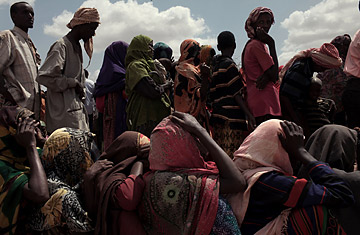
Somali refugees arrive at the Dadaab Refugee Camp in eastern Kenya, July 18, 2011.
(2 of 2)
At the reception area where new arrivals are registered and receive a food ration, a man with visible strain on his face, Abdikarim, is comforting his family. He came from Mogadishu with his 2 boys and 3 girls. They arrived at the border in the back of a truck and then walked the 100 kilometers to the camp. They had no food for three days, he tells me. A mother, Hawo, has a distracted, yet urgent, gaze, as she describe how she left four of her children and her husband in Mogadishu, and came here with only her 10-year-old daughter, Farhiyo. The journey took them five days, with little food or water.
"This is the most problematic and challenging refugee situation in the world," said Antonio Guterres, the chief of the UN refugee agency (UNHCR), which runs the camps, who made a visit to the camps earlier this month to press the Kenyan government to allow UNHCR to expand the existing camps.
Guterres' visit appears to have been a success. Late last week the Kenyan government announced it may allow the opening of Ifo II, a new camp that had originally been slated to get underway last November but that been blocked by local officials who wanted a greater say in how the camp was designed and set up as well as compensation for use of the land. Central government officials said they were concerned about security, having in mind sensitive Kenyan ethnic, territorial, and electoral politics.
The Ifo II camp is designed to hold 40,000, so it will take off some of the pressure, but with the camps already at four times their capacity, with 70,000 in the outskirts and the numbers increasing daily, it won't be nearly enough. UNHCR says it has other camp sites that could hold several hundred thousand more people, but they have yet to be built, and at this point it seems unlikely the Kenyan government would be willing to allow such a large expansion.
Kenyan Prime Minister Raila Odinga says that new feeding programs should be done in Somalia, not Kenya. Whether that is viable is questionable. The al-Shabab Mujahideen, an Islamist militia group, had prevented the World Food Program and other international relief agencies from working in Somalia since last year, but have recently said they would be willing to lift the ban. Relief groups say al-Shabab's promises mean little unless there are concrete safety measures in place.
Meanwhile, the aid machinery is in full swing, with official visits already under way from rich country ministers and heads of state, and aid agencies courting journalists and donors in a bid to raise emergency funds. Millions of new dollars have been pledged in the last week. But given that these camps have been in a badly overcrowded state for more than a decade, and the current drought was forecast from the beginning of the year, it makes one question what took so long. And with no end in sight for the Somali conflict, and climate change leading to droughts in the region that are harsher and longer term, opening new camps, wherever they may be, is at best a short term solution. The original camps were supposed to be short-term too — and that was 20 years ago.
This story was reported with a grant from the Pulitzer Center on Crisis Reporting.
